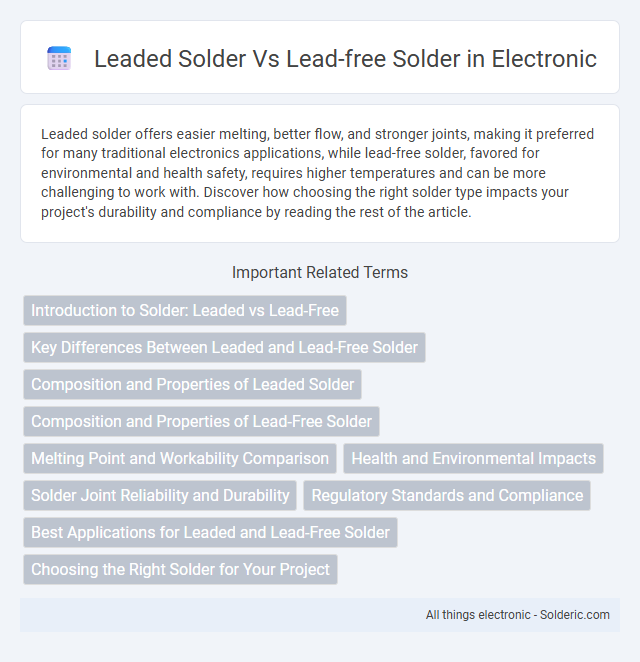Leaded solder offers easier melting, better flow, and stronger joints, making it preferred for many traditional electronics applications, while lead-free solder, favored for environmental and health safety, requires higher temperatures and can be more challenging to work with. Discover how choosing the right solder type impacts your project's durability and compliance by reading the rest of the article.
Comparison Table
| Feature | Leaded Solder | Lead-Free Solder |
|---|---|---|
| Composition | Typically 60% tin, 40% lead (Sn60Pb40) | Tin-based alloys (e.g., Sn96.5Ag3.0Cu0.5) |
| Melting Point | 183degC (361degF) | 217-221degC (423-430degF) |
| Toxicity | Contains lead, toxic and hazardous | Lead-free, environmentally safer |
| Electrical Conductivity | Good conductivity | Comparable but slightly lower conductivity |
| Mechanical Strength | Good mechanical strength | Often harder, more brittle |
| Reliability | Proven long-term reliability | Improving, industry standard in RoHS-compliant products |
| Environmental Impact | Harmful due to lead content | Complies with RoHS and environmental regulations |
| Cost | Generally cheaper | Typically more expensive |
Introduction to Solder: Leaded vs Lead-Free
Leaded solder, traditionally composed of tin and lead, offers excellent electrical conductivity and a lower melting point, making it easier to work with in electronic assembly. Lead-free solder, typically made from a combination of tin, silver, and copper, provides a safer, environmentally friendly alternative while often requiring higher temperatures and careful handling to ensure reliable joints. Your choice between leaded and lead-free solder impacts both performance and compliance with environmental regulations like RoHS.
Key Differences Between Leaded and Lead-Free Solder
Leaded solder contains a blend of tin and lead, typically 60/40, offering lower melting points and superior wettability, which facilitates easier application and stronger joints. Lead-free solder, primarily composed of tin, silver, and copper (SAC alloys), melts at higher temperatures and requires precise handling to avoid thermal damage during soldering. Your choice between leaded and lead-free solder affects environmental impact, health safety, and compliance with regulations like RoHS, making it crucial to assess application requirements.
Composition and Properties of Leaded Solder
Leaded solder typically consists of a tin-lead alloy, commonly 60% tin and 40% lead, which provides a low melting point around 183degC and excellent electrical conductivity. Its malleability and superior wetting properties ensure strong, reliable joints in electronic components. Despite its effectiveness, leaded solder's environmental and health hazards have driven the industry towards lead-free alternatives.
Composition and Properties of Lead-Free Solder
Lead-free solder typically consists of a tin-based alloy combined with metals such as silver, copper, and sometimes bismuth or indium to enhance its properties. This composition offers improved environmental safety by eliminating toxic lead, but it often requires higher melting temperatures compared to traditional leaded solder. Your choice of solder affects joint reliability and electrical performance, with lead-free varieties providing strong mechanical strength and better thermal fatigue resistance in modern electronics.
Melting Point and Workability Comparison
Leaded solder typically has a lower melting point around 183degC compared to lead-free solder, which melts between 217degC and 227degC, impacting heat sensitivity during soldering processes. The workability of leaded solder is often preferred in electronics due to its smoother flow and better wetting properties, making solder joints easier to form and more reliable. Your choice between leaded and lead-free solder affects not only melting behavior but also the ease and quality of the soldering task.
Health and Environmental Impacts
Leaded solder contains toxic lead, posing significant health risks such as lead poisoning and neurological damage during manufacturing and disposal processes. Lead-free solder, often composed of metals like tin, silver, and copper, reduces harmful environmental contamination and complies with regulations like RoHS, protecting ecosystems and human health. Choosing lead-free solder improves your workplace safety and minimizes ecological harm by avoiding hazardous lead emissions.
Solder Joint Reliability and Durability
Leaded solder typically offers superior solder joint reliability and durability due to its lower melting point and better wettability, which results in stronger, more resilient connections under mechanical stress. Lead-free solder, while environmentally friendly, often forms joints that are more brittle and prone to cracking over time, especially in high-temperature or vibration-intensive applications. Your choice between the two should consider the specific durability requirements and operating conditions of the electronic device.
Regulatory Standards and Compliance
Lead-free solder complies with RoHS (Restriction of Hazardous Substances) directives, ensuring lower environmental and health risks by eliminating lead content. Leaded solder, although offering superior mechanical strength and conductivity, faces increasing restrictions in consumer electronics due to strict regulations in the EU, US, and other regions. Your choice of solder must align with relevant regulatory standards to guarantee product safety and market access.
Best Applications for Leaded and Lead-Free Solder
Leaded solder, composed primarily of tin and lead, excels in applications requiring low melting points and superior mechanical strength, making it ideal for traditional electronics repair and prototyping. Lead-free solder, typically a blend of tin, silver, and copper, is preferred for environmentally sensitive and regulatory-compliant manufacturing, especially in consumer electronics and automotive industries. Your choice between leaded and lead-free solder should consider factors such as thermal performance, environmental regulations, and the specific requirements of the electronic assembly.
Choosing the Right Solder for Your Project
Selecting the right solder depends on the project's requirements, environmental regulations, and performance needs. Leaded solder, typically composed of 60% tin and 40% lead, offers excellent electrical conductivity and ease of use with lower melting points, making it ideal for prototyping and electronics repair. Lead-free solder, usually made from tin combined with silver, copper, or bismuth, complies with RoHS standards and provides greater environmental safety and durability for commercial and consumer electronics.
leaded solder vs lead-free solder Infographic

 solderic.com
solderic.com